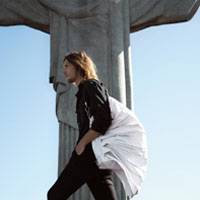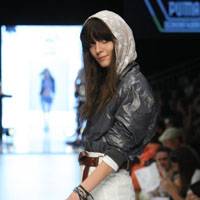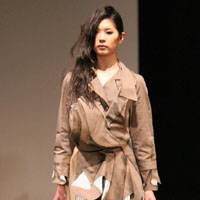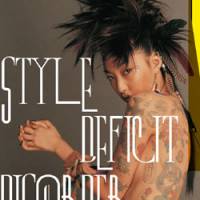Cure for disorder
The popular fashion hub Harajuku is the subject of a fascinating new book by Tokyo-based editor and creative consultant Tiffany Godoy. Rich in detail and accompanied by some remarkable images, her book, "Style Deficit Disorder" (Chronicle Books), documents the history of the area from World War II until the present day, tracking its continuing fluctuations.
Godoy, speaking to The Japan Times, says that she wanted to "give people the feel that they are in Harajuku" and to see what she calls "the living magazine, the stylistic catchball."
The book has insightful essays by key players and fashion journalists such as Tetsuya Suzuki, editor of hip style Web site Honeyee.com, and highlights include deeply researched segments on the Harajuku fashion haven La Foret, feted label Comme des Garcons, cult magazine Fruits and the rise and fall of "Hokoten," the impromptu weekly pedestrian parade.
But it's Godoy's presentation of the Ura-Hara movement (young, mostly male, hip-hop/skater-influenced designers led by style guru Hiroshi Fujiwara) and the post-Harajuku scene (a new wave of labels and club kids not originally from Harajuku) that really excels. Her perceptive essays on well-known brands such as BAPE and Undercover, and on Fujiwara, make the book essential reading for anyone who wants to get the real lowdown on the fabled district.
"Style Deficit Disorder" ends with a peek into the future as Godoy paints a portrait of a revolutionary culture of post-Hara kids with such energy and attitude that it could fill another volume entirely on its own. (Paul McInnes)
Available from ¥3,130; www.styledeficitdisorder.com
Fashion students strutting
Established in 2003, Bunka Fashion Graduate University touts itself as the first institution in Japan with a curriculum aiming to foster the creativity and business savvy in young designers that's required to take their brands global. With this goal in mind, former graduates Hiroko and Junko Koshino and Yohji Yamamoto — designers and institutions in their own right — teach there as visiting professors. Two years of study result in around 80 select students producing a final collection rather than the standard master's thesis.
Feb. 12 marked the first time the top first and second-year collections were shown on the same runway. As witnessed by industry insiders, including buyers for department stores and boutiques, the strong, sexy and social message-laden clothing was proof that these kids have already moved way beyond Finger Painting 101.
Highlights came from second-year students, who showed off their practical clothes to a backdrop of high energy music and attitude.
Aya Nakayama presented a thoughtful set of trench coats with deceptive trompe l'oeil patterns whose rippling fabric suggested a rustling wind. For the climax, her last coat was literally blown apart in an onstage storm.
Waka Karimura showed ladies streetwear: hoodies and dresses bearing messages encouraging media literacy and prints of the face of Yutaka Narita, president of the faceless advertising conglomerate Dentsu. To a high-octane soundtrack warning "This is dangerous," Takefumi Yamasaki presented clothes done in light and brightly colored designs that were inspired by wild animals.
If this is the next generation of Japanese creators, then we are certainly headed for some interesting times. (Misha Janette)
3-22-1 Yoyogi, Shibuya-ku Tokyo; (03) 3299-2701; www.bfgu-bunka.ac.jp
Message in a bag
The spirit of the French student protests of May 1968 are the inspiration behind an intriguing collaboration between English leather-goods brand Bill Amberg and Japanese fashion label AMACA. Their new limited-edition tote bags — in a variety of colors from yellow and orange to khaki and black — come emblazoned with the rousing slogan, "Sous les paves, la plage (Underneath the paving stones, the beach)."
Made from 100 percent canvas and beautiful calf-leather handles, the bags' message is more environmental than political, though. The project is intended as a call to consumers to be more aware of current ecological and environmental issues and realize that nature continues churning away right under our ignorant urban feet.
The eye-catching illustration and bold colors gives an added punch to the new genre of eco and message bags. To back up the words, from Feb. 22 to March 6th, AMACA will produce shopping bags made from recycled paper, with a portion of the profits going to environmental NGO Green Cross Japan.
In addition to being sold in 41 AMACA stores in Japan, the bags will be simultaneously available in Bill Amberg's cool flagship store in the trendy Notting Hill area of London. (Paul McInnes)
Available at AMACA stores nationwide; (0120) 340-460; www.sanyo-shokai.co.jp
Wicked, sexy, street
Sportswear giant Puma recently launched "Rudolf Dassler by Puma," a new sports/fashion line of apparel for men and women. The elegant streetwear comes after various Puma projects and collaborations with top designers such as Yasuhiro Mihara and Alexander McQueen. Named after the original founder Rudolf Dassler (brother of Adidas creator Adolf), the new label seeks to fuse classic silhouettes with edgy streetwear.
The line's Spring/Summer 2008 collection premiered at last year's Berlin Fashion Week, modeled most noticeably by top model and former Pete Doherty-muse Irina Lazareanu (right). Riffing on a "Back to the Future" theme, the fusion of contemporary textiles and Modernist hexagonal logos — in summer colors such as white, gray, orange and purple — has created a hot fuss with its sexy street image and retro appeal. The slim-fitting striped garments with light hoods are touched up with iconic graphics from the Dassler archive, making the collection a treat for fashion fans with a sporty predilection. (Paul McInnes)
The Puma Black Store is in Tokyo Midtown; (03) 5413-7150; www.puma.com
Brazilian fashion adventure
Twenty years ago, Brazilian orthopedist Oskar Metsavaht sewed himself a warm winter coat for a mountain-climbing expedition in Argentina. A hit with fellow extreme sports fans ever since — and these days international seekers of cool and functional luxury alike — the coat, and subsequent designs inspired by his numerous travels, launched the popular Brazilian brand Osklen.
The Rio de Janeiro-based shop was once a hangout for celebrities visiting the natural wonders of Ipanema, a neighborhood in Rio. Now it's its own community and acts as an advocate for environmental issues by encouraging eco-friendly lifestyles with a "No worries" attitude. The brand is arguably one of Brazil's most successful to date, with 46 stores worldwide from New York to Belgium, the Middle East and now the Far East.
Opening last December, a free-standing Osklen boutique featuring men's and ladies' collections fills two floors in the back streets between Shibuya's bustling train station and Yoyogi Park.
"I insisted that even the location exhibit the brand's spirit," says Metsavaht, "merging urban convenience and function with as much of nature possible."
So look to it — from hanging 10 on the waves to sipping cocktails in the lounge — as a way to be responsible, and look impeccably cool. (Misha Janette)
1-6-14 Jinnan, Shibuya-ku; (03) 5457-1127; www.osklen.com







